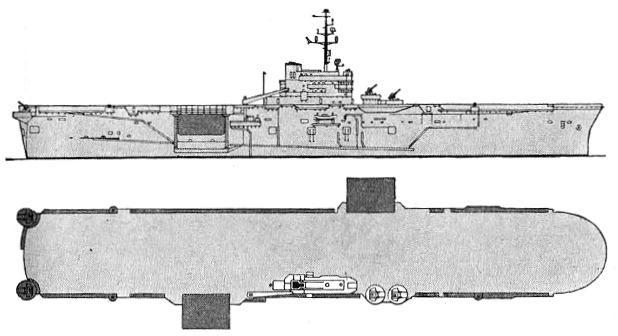

Iwo Jima 1963
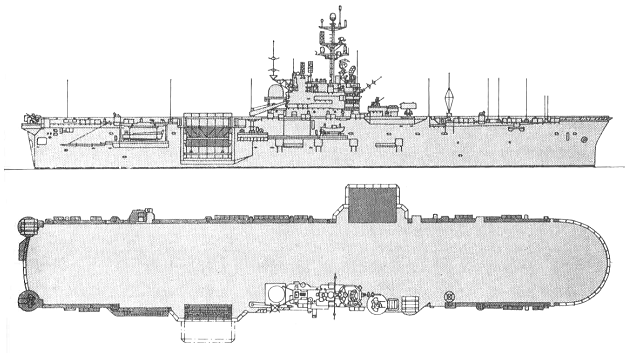
Iwo Jima 1979
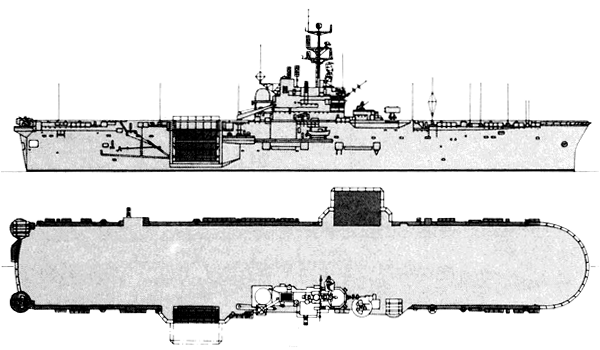
Iwo Jima 1990
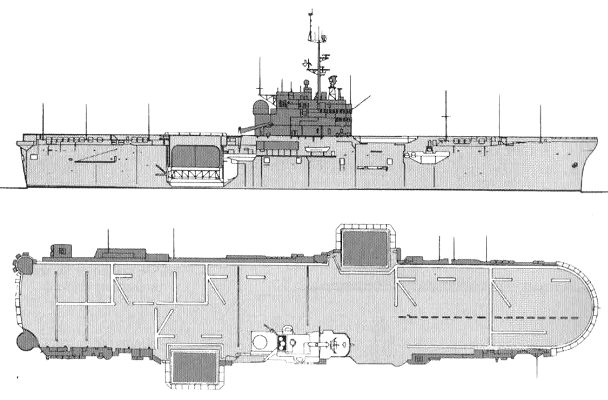
Inchon 2000
| No | Name | Yard No | Builder | Laid down | Launched | Comm | Fate |
| LPH2 | Iwo Jima | Puget Sound N Yd, Bremerton | 2.4.1959 | 17.9.1960 | 26.8.1961 | stricken 9.1993 | |
| LPH3 | Okinawa | Philadelphia N Yd | 1.4.1960 | 19.8.1961 | 14.4.1962 | stricken 12.1992 | |
| LPH7 | Guadalcanal | Philadelphia N Yd | 1.9.1961 | 16.3.1963 | 20.7.1963 | stricken 8.1994 | |
| LPH9 | Guam | Philadelphia N Yd | 15.11.1962 | 22.8.1964 | 16.1.1965 | stricken 8.1998 | |
| LPH10 | Tripoli | 1105 | Ingalls, Pascagoula | 15.6.1964 | 31.7.1965 | 6.8.1966 | stricken 9.1995 |
| LPH11 | New Orleans | Philadelphia N Yd | 1.3.1966 | 3.2.1968 | 16.11.1968 | stricken 10.1998 | |
| LPH12, 3.1995- MCS12 | Inchon | 1156 | Ingalls, Pascagoula | 8.4.1968 | 24.5.1969 | 20.6.1970 | mine countermeasures support ship 3.1995, stricken 5.2004 |
|
Displacement standard, t |
10717 |
|
Displacement full, t |
18004 |
|
Length, m |
169.5 wl 183.6 oa |
|
Breadth, m |
25.7 |
|
Draught, m |
8.00 |
|
No of shafts |
1 |
|
Machinery |
LPH2, 3, 7, 11: 1 set Westinghouse geared steam turbines, 2 Combustion Engineering boilers LPH9: 1 set Westinghouse geared steam turbines, 2 Babcock & Wilcox boilers LPH10: 1 set De Laval geared steam turbines, 2 Combustion Engineering boilers LPH12: 1 set General Electric geared steam turbines, 2 Combustion Engineering boilers |
|
Power, h. p. |
22000 |
|
Max speed, kts |
23.5 |
|
Fuel, t |
oil |
|
Endurance, nm(kts) |
|
|
Armament |
4 x 2 - 76/50 Mk 33, 19 CH-46 or 11 CH-53 helicopters (standard 24 CH-46, 4 CH-53, 4 UH-1) |
|
Military load |
LPH2, 3, 7, 9-11: 2057 troops LPH12: 2057 troops, 2 LCVP |
|
Electronic equipment |
LN-66, SPS-10, SPS-40, SPN-10, 2x Mk 34 radars, WLR-1 ECM suite |
|
Complement |
667 |
Project history: These ships were the culmination of a long Marine Corps development of vertical envelopment, or helicopter assault. The basic motivation was fear of nuclear bombardment of concentrations of landing craft off relatively restricted beaches; helicopters could approach from greater distances, preserving concentration of the assault troops at the beaches while permitting dispersal of assault shipping. Probably the single greatest defect of the LPH was its inability to operate landing craft. Thus it could not attack or support troops on the beach in rough weather, and its helicopters could not move heavy equipment over a beach. The Iwo Jima class helicopter carriers were designed at 1957 after studies of the conversion of alternative hulls, including some of the wartime fast battleships. In fact three Essex class ASW carriers were converted to become austere LPHs with cargo stowed on their former hangar decks. They retained their 127mm batteries for shore bombardments, a capability not matched by the specially-built LPH (but in fact restored in the later LHA). The basic LPH design incorporated provision for conversion to an ASW helicopter carrier, aid in this sense provided a full replacement for the CVS conversions. However, unlike the Essex class CVS, the Iwo Jimas could not operate fixed-wing aircraft, since the design never incorporated either a catapult or arresting gear. Note that, at the time of design, there was no question of retiring the Essex class CVS.
Converted aircraft carriers had not enough space for Marines. The Iwo Jimas solved this problem. Their troop spaces, accommodating 2000 troops, were air conditioned, and there were special vehicle stowage areas and special cargo facilities. Flight decks were 'spotted' to accommodate seven CH-46 or four CH-51 helicopters for take-off; the hangar can accommodate, respectively, 19 and 11 of these helicopters. When helicopters are heavily laden, they benefit from take-off runs, so that effective operation limits the number of helicopter 'spots'.
Modernizations: 1970, Okinawa: - 1 x 2 - 76/50; + 1 x 8 Sea Sparrow SAM (8 RIM-7), Mk 115 radar
1972, Tripoli, Inchon; 1973, Iwo Jima, New Orleans; 1974, Guadalcanal, Guam: - 2 x 2 - 76/50, 2x Mk 34 radars; + 2 x 8 Sea Sparrow SAM (8 RIM-7), 2x Mk 115 radars
1973, Okinawa: - 1 x 2 - 76/50, 2x Mk 34 radars; + 1 x 8 Sea Sparrow SAM (8 RIM-7), Mk 115 radar
1983-1986, all: + 2 x 6 - 20/76 Mk 15 Phalanx, 2x Mk 90 radars
early 1980s, Iwo Jima, Okinawa, New Orleans; late 1980s, Guadalcanal, Guam, Tripoli, Inchon: - WLR-1 ECM suite; + SLQ-32(v)3 ECM suite, 4x Mk 36 SRBOC decoy RL
early 1980s, Iwo Jima, Okinawa, Guadalcanal, Guam, Tripoli, New Orleans: - SPN-10 radar; + SPN-35, SPN-43 radars
early 1980s, Inchon: - SPN-10 radar; + SPN-43 radar
1995, Inchon: - 2 x 8 Sea Sparrow SAM, 2 x 2 - 76/50, 2x Mk 115 radars; + 4 x 1 - 25/75 Mk 38 Bushmaster, can carry 11 MH-53 minesweeping helicopters
Naval service: In 1971 Guam was modified as a prototype Sea Control Ship; she was later refitted as an LPH. Inchon operated minesweeping helicopters in Operation Endsweep, the clearance of the ports of North Vietnam in 1973. Tripoli was mine countermeasures HQ ship during the Gulf conflict; was mined 18.2.1991. Other units also served in the capacity of countermine mothership. Inchon was reclassified as Mine Countermeasures Command and Support Ship in 1995. She was severely damaged by fire 19.10.2001, laid up unrepaired in June 2002 and finally sunk 5.12.2004.
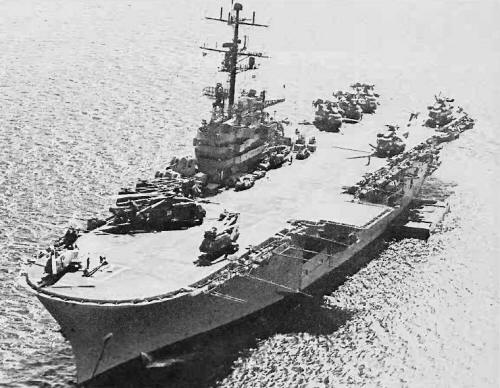
New Orleans 1973
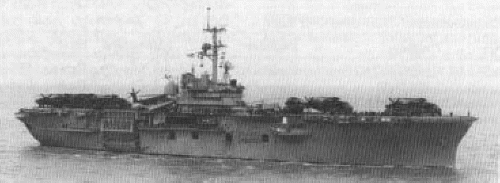
Inchon 1993
© Ivan Gogin, 2015